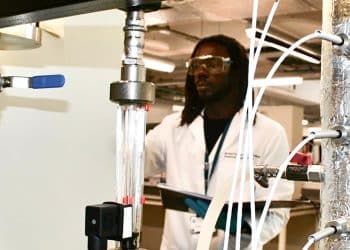Non-communicable diseases cause over 70% of worldwide deaths. [1] They include cardiovascular disease, cancer, and diabetes. Lifestyle factors play a major role: poor diet, for example, is associated with one in five of the aforementioned deaths. Diets such as the Mediterranean diet are high in bioactive compounds that help protect against these lethal diseases.
Reprinted from: Câmara JS, Albuquerque BR, Aguiar J, et al. Food bioactive compounds and emerging techniques for their extraction: polyphenols as a case study. Foods. 2021;10(1). doi:10.3390/foods10010037. License: CC BY 4.0
Broadly, food polyphenols branch into two types: flavonoid and non-flavonoid. The first group includes powerful compounds like flavonols (e.g., quercetin) and anythocynanins (e.g., red and purple pigments in flowers and fruits). The latter group includes phenolic acids, stilbens (e.g., resveratrol), and tannins.
Polyphenols pack serious health benefits spanning “antioxidant, antiatherogenic, anti-inflammatory, antimicrobial, antithrombotic, cardioprotective, and vasodilator properties.” This encompasses various non-communicable diseases (see image).
For example, one clinical study [2] found that resveratrol at 800 mg/day exerted significant antioxidant effects in type 2 diabetic patients, reducing weight, body mass index, and blood pressure. Another clinical trial illustrated that 200-400 mg quercetin caused acute vasodilation. [3] Polyphenols may protect against cardiovascular disease through additional mechanisms like reducing cholesterol, blood glucose, and inflammation. Anthocyanins from cherry juice were found to improve verbal fluency and memory in dementia patients. [4] The sulforaphane in broccoli is a “promising anticancer agent.”
Applications extend to ultraviolet light protection (i.e., sunscreen) and antimicrobial properties relevant to skincare. A polyphenol from green tea, epigallocatechin-3-gallate (EGCG), was even found to boost human hair growth. [5] Polybalm® harnesses polyphenols to prevent nail damage from chemotherapy.
Industrial uses for polyphenols include natural dyes for textiles to replace toxic conventional dyes. They are also relevant as natural color additives and preservatives for food products.
Conventional polyphenol extraction techniques like Soxhlet extraction suffer limitations: they are inefficient, use large amounts of solvent, and require significant time and labor. Câmara et al [1] cover two newer solutions, namely advanced extraction techniques and emerging extraction techniques.
Advanced Techniques
- Pressurized liquid extraction
- Ultrasound-assisted extraction (UAE)
- Microwave-assisted extraction (MAE)
- Microextraction
Emerging Techniques
- Super- and subcritical fluid extraction
- Pulsed-electric fields extraction
- High-voltage electric discharge
- Nano-sorbent extraction
The emerging techniques are more recent; in general, both improve efficiency, cost, and sustainability compared to conventional extraction methods.
Supercritical carbon dioxide (CO2), for example, has been used at 250 bar and 50ºC with an ethanol co-solvent (1.2%) to effectively extract polyphenols (including EGCG) from green tea leaves [6]. Subcritical water extraction has been patented as an effective method for polyphenols from various fruits and vegetables. UAE may be the most commonly employed newer method.
Extracting polyphenols depends largely on the target analyte, raw material, and cost. Extractors may implement clean-up procedures such as solid-phase extraction to remove unwanted pigments, waxes, sugars, etc. [1] The compounds and their sources are varied across foods, and polyphenols are only one type of food bioactive. The possibilities for these powerful components in food thus seem endless.
References
1- Câmara JS, Albuquerque BR, Aguiar J, et al. Food bioactive compounds and emerging techniques for their extraction: polyphenols as a case study. Foods. 2021;10(1). doi:10.3390/foods10010037. [Impact Factor: 4.350; Times Cited: 7 (Semantic Scholar)]
2- Seyyedebrahimi S, Khodabandehloo H, Nasli Esfahani E, Meshkani R. The effects of resveratrol on markers of oxidative stress in patients with type 2 diabetes: a randomized, double-blind, placebo-controlled clinical trial [published correction appears in Acta Diabetol. 2018 Oct;55(10):1087]. Acta Diabetol. 2018;55(4):341-353. doi:10.1007/s00592-017-1098-3. [Impact Factor: 4.280; Times Cited: 56 (Semantic Scholar)]
3- Perez A, Gonzalez-Manzano S, Jimenez R, et al. The flavonoid quercetin induces acute vasodilator effects in healthy volunteers: Correlation with beta-glucuronidase activity. Pharmacol Res. 2014;89:11-18. doi:https://doi.org/10.1016/j.phrs.2014.07.005. [Impact Factor: 7.658; Times Cited: 60 (Semantic Scholar)]
4- Kent K, Charlton K, Roodenrys S, et al. Consumption of anthocyanin-rich cherry juice for 12 weeks improves memory and cognition in older adults with mild-to-moderate dementia. Eur J Nutr. 2017;56(1):333-341. doi:10.1007/s00394-015-1083-y. [Impact Factor: 5.614; Times Cited: 101 (Semantic Scholar)]
5- Kwon OS, Han JH, Yoo HG, et al. Human hair growth enhancement in vitro by green tea epigallocatechin-3-gallate (EGCG). Phytomedicine. 2007;14(7):551-555. doi:https://doi.org/10.1016/j.phymed.2006.09.009. [Impact Factor: 4.268; Times Cited: 96 (Semantic Scholar)]
6- Gadkari PV, Balarman M, Kadimi U.S. Polyphenols from fresh frozen tea leaves (Camellia assamica,) by supercritical carbon dioxide extraction with ethanol entrainer – application of response surface methodology. J Food Sci Technol. 2015;52:720–730. https://doi.org/10.1007/s13197-013-1085-9. [Impact Factor: 2.701; Times Cited: 21 (Semantic Scholar)]
Image: PublicDomainPictures from Pixabay













